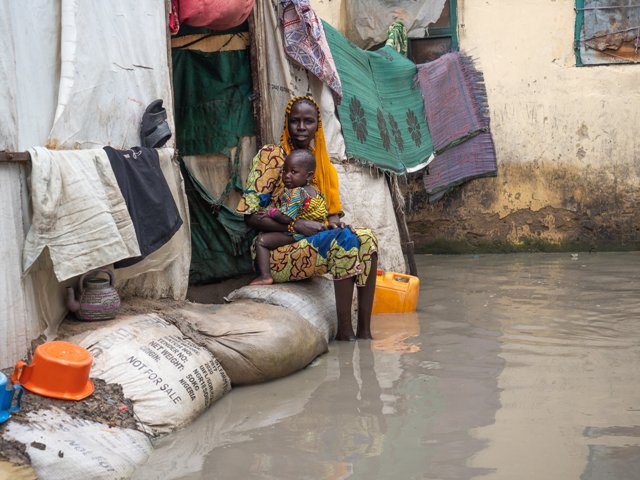IOM evaluating needs of displaced persons affected by floods in Bangui
The DTM makes it possible to observe the movements of displaced persons, identify their main needs and make referrals for humanitarian assistance.

- Country:
- Central African Republic
Heavy rains falling in Bangui, Central African Republic, since 21 October, continue to cause significant material damage and make more vulnerable a population already affected by repeated cycles of violence since 2013. Such heavy rains are unusual in November.
In Bangui, the country’s capital, the International Organization for Migration (IOM)’s Displacement Tracking Matrix (DTM) estimates that 20,691 people, displaced by the severe weather, are now living in host families, adding pressure on a population already suffering from violence and poverty. IOM, together with the Central African Red Cross, is currently evaluating the needs of those displaced by the floods.
So far IOM has provided about 1,000 emergency shelters for internally displaced persons at affected sites during the emergency response phase. Nonetheless, addressing basic needs (health, water, hygiene, emergency shelter, and household items) remains a priority.
Last week, DTM carried multisector evaluations in the four affected districts of the capital, with the majority of them being partially flooded for three weeks now. The amount of people affected by the floods is expected to rise as the Central Africa Red Cross is currently registering people living in displacement sites.
“The situation is very difficult here. The neighbors have sheltered us, but we lack everything, and we can’t sleep as there are too many mosquitoes due to the stagnant water,” said Beatrice, mother of five whose house has been flooded for three weeks. Beatrice and her family found refuge in the neighboring Maya-Maya district, which is also partially affected by the floods.
“We have no income and arable fields are completely flooded. We are afraid for the coming weeks,” she added.
The Central African Red Cross oversees site management planning. UN agencies such as UNHCR, WFP, WHO, UNFPA, and UNICEF have already mobilized to aid affected communities while international NGOs offer support for water, hygiene, sanitation, and health needs.
However, the needs remain very critical: several other areas of the country have suffered damage, the scale of which is gradually being determined.
The DTM makes it possible to observe the movements of displaced persons, identify their main needs and make referrals for humanitarian assistance. IOM in the Central African Republic plans to launch multisectoral needs assessments and household evaluations on sites.
(With Inputs from APO)
ALSO READ
Floods swamp scores of settlements in Russia and Kazakhstan
Bringing hope in times of despair: 200 babies born in shelters for displaced in Manipur
More than 97,000 people evacuated as floods hit Kazakhstan
EXPLAINER-Floods in Russia and Kazakhstan: How bad are they?
Kremlin on floods: water is still rising and forecast is not favourable










